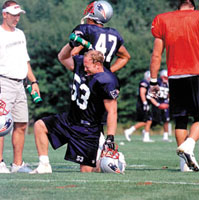Hasselblad Zeiss Telephoto Power Pack
A 300mm f2.0 APO Redefines MF Sports Photography
When you think about really
long, really fast glass, you naturally think of 35mm. I have owned both
Hasselblad and Mamiya RZ systems for years, and the longest lens I own
is a 180mm. I'm like most shooters--I think of compact and
portable 35mm as the long lens sports format, and 21/4 as the normal lens,
studio strobe kind of system. Then I got hold of the Hasselblad Zeiss
Telephoto Power Pack! |
|||
When the box arrived from
Hasselblad U.S.A. I was both intimidated and impressed. I've never
handled such a large and impressive piece of glass on a Hasselblad body,
and just putting the whole thing together took a few minutes. The lens
and tele-extender are part of the FE series, and require a 200-series
Hasselblad body. Since these lenses have no leaf shutters they require
a focal plane shutter body. As with most things Zeiss this is a remarkably
well-crafted item. Fit and finish are beyond reproach. The silver finish
seems to glow, all of the markings and engravings are crisp and clear,
and the large blue "Zeiss" logo brings a smile to the face
of any certified equipment nut. Even the tele-extender is a typical
Zeiss piece, its large "Made In Germany" label carefully
engraved into the body of the lens. |
|||
I had to find out. I'm
sort of a studio guy, with the weekly location shoot, usually in an office
building or factory. Mine is the world of carefully controlled conditions,
beautifully lit scenes and plenty of time to study the Polaroids. Sports
guys have to shoot first and ask questions later. To really put this beauty
through its paces I gathered up my kit of Hasselblad bodies and lenses
as well as my EOS D60 and 1D bodies, my 70-210mm L and 300mm f/2.8 L lenses,
and enough Fuji Provia 100 film to cover me and packed up the car. Setting Up Shop |
|||
"What the hell is that?"
asked a local photojournalist. "Why, this is my Zeiss 300mm f/2.8
APO with 1.7x APO-Mutar extender on a 203FE body with PM 90 prism,"
I casually remarked. Impressed, he shrugged and walked away. Needless
to say, when I staked out a position the print journalists cleared a space
for the guy with the prettiest lens. |
|||
Through The Loupe |
- Log in or register to post comments





































